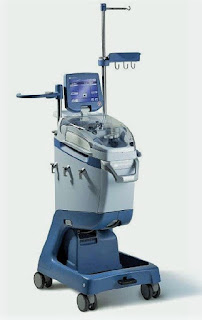IV Fluids
A) Crystalloid solutions (< 30 000 Dalton):
1-Hypotonic solutions:
- D5W,
½ NS, D5 ¼ NS, D5 ½ NS.
2-Isotonic solutions:
- NS,
Ringer’s, Lactated Ringer’s (Hartmann’s), Ringer’s acetate.
3-Hypertonic solutions:
- NaCl (3%, 7.5%), Mannitol (10%, 20%), NaHCO3 (5%, 7.5%, 8.4%).
B) Colloid solutions (> 30 000 Dalton):
1-Blood derived:
- Human
albumin (5%, 25%).
- Plasma
protein fraction 5%.
2-Synthetic:
a) Dextrose Starches:
- They are
D-glucose polymers linked by alpha bonds into linear macromolecules prepared
from sucrose.
- Their half-life is 12 hours.
- 6% Dextran-70
(Macrodex) MW = 70 000 Dalton
- 10%
Dextran-40 (Rheomacrodex) MW = 40 000 Dalton
- Dextran-1
(Promit).
- Dose: 20
ml/kg/d., Max.: 1.5 L/d.
Disadvantages:
- Interfere
with blood typing.
- Antiplatelet
effect.
- Antigenic
effect with anaphylactoid and anaphylactic reactions.
- Affects renal functions and can be associated with renal failure.
b) Gelatins:
- Their M.W.
30 000-35 000 Dalton.
- Their half-life
is 4-5 hours.
- Succinylated
Gelatin (Gelofusine 3.5%, 4%).
- Polygelline
(Hemaccel 3.5%, Hemagel 4%).
- Dose: 20
ml/kg/d., Max.: 1.5 L/d.
Advantages:
- Does not
interfere with blood grouping.
- Does not
affect renal function.
Disadvantages:
- Histamine-mediated allergic reaction.
c) Hydroxy-Ethyl Starch (HES) (Etherified Starch):
Synthetic
colloids resemble glycogen structurally, synthesized from amylopectin.
- Heta-starch
(Hexa-starch) (e.g. HAES-Steril, Hespan): M.W. 450 000 Dalton, half-life 48 hours.
- Hextend: M.W.
is higher, and the half-life is longer.
- Penta-starch:
M.W. 200 000, half-life less than 24 hours.
- Tetra-starch:
(e.g. Tetraspan, Voluven): M.W. 130 000, half-life less than 6 hours.
- Dose: 20-50
ml/kg/d.
Advantages:
- Do not
affect the coagulation study.
- Not
antigenic but can cause anaphylactoid reactions.
- Less expensive than human albumin.


































